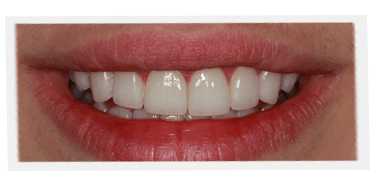
Now that we’ve considered what’s in the dentist’s toolbox, its time to see these materials and procedures in action. How do dentists actually assess and correct real smile problems?
To answer this question, let’s turn to the actual smile problems people experience and the general range of solutions available. What you’re about to read could be eye-opening for you if you are one of the many who think that their smile problem has no solution – or that every solution is difficult and expensive.
(Taken from my book, A Guide to the Perfect Smile.)
Gummy Smile
Everyone is different. Their muscles work differently. The way they exert them differs in rhythm, force, and duration. Even people of similar body type and weight and strength and bone structure can have widely different ways and speeds of smiling. Another way to put this is to say that the movements of their smiles vary in animation.
People with excess gum may have a static smile and therefore show very little gum. Static smilers, once their smiles are fully operational, show perhaps 0 to 1 mm of gum. However, that same amount of gumminess in an individual who has a dynamic, animated smile will be problematic.
Some dynamic smilers who have a gummy problem will not in fact show it in their basic smile. However, because their muscular movement is animated, they may go too quickly from showing very little tooth and gum in that basic smile to showing remarkable amount in a large, expanded smile. That sudden display is shocking for people to see. It would be better to show gum all the time than to go from showing little gum to a lot of gum.
If your smile is animated in this way, the question is whether you show gum nearly all the time or very little until you smile, then, boom, it hits everyone is sight.
Before exploring an aesthetic solution, you and your dentist should determine whether the problem is health-related. If, in instance, you have gingivitis or periodontal disease, that must be dealt with first (and may require the services of a periodontist). This treatment may actually clear up your problem. If not, there are several aesthetic solutions.
Solution: Gummy smiles can generally be treated either by putting crowns or veneers on the teeth to lengthen them or through a simple correction of the gums. There are five main types of gum solutions.
Level 1: Sometimes a person will have a gum line that, from birth, has never receded properly. The person appears to have a gummy smile because there is excess gum for the amount of anatomical tooth beneath the gum. X-rays would show the parts of the teeth below the gum that could be exposed. The excess gum can be easily removed with a procedure no more complicated than removing excess cuticle from your fingernails – though in this case it is done with a laser. The procedure was painless. It doesn’t require sutures. A topical anesthetic can be used to make the patient more comfortable. Within five to ten minutes, the excess gum is trimmed away, never to grow again, exposing the long, full, beautiful teeth that have been buried under tissue.
Level 2: Sometimes the teeth are in their correct position in relation to the gums, but too much gum is showing between the teeth and the lip line because the person has a very animated smile.
This can be corrected, but it may require a more advanced appraisal to determine how much gum can be removed. This appraisal is done through a procedure called sounding. Using a thin metal probe, the dentist is able to determine how much gum can be removed by the laser without weakening the underlying structure.
Level 3: Sometimes gum reduction is clearly needed aesthetically but is problematic dentally because the underlying bone is too close to the gum. Not only does the gum have to be removed, but part of the underlying bone has to be removed as well.
The procedure for doing this usually requires a periodontal and laser treatment. An extended period of time must be allowed for healing before veneers or crowns are placed on the teeth.
Level 4: Some patients clearly have a gummy smile but the teeth, gums, and bone are perfectly positioned, leaving no room to adjust any variable. In such a case, a surgical technique can be performed in which the jaw itself is moved up so that when the patient smiles the gum will not be seen to as great an extent. The gums, bone, and teeth are moved in conjunction with each other to eliminate the gummy smile. This surgical procedure is called a palatal impaction or La Forte procedure.
Level 5: There are cases in which the patient’s teeth, gum, and bone are in proper aesthetic relationship to each other, but the patient animates too much when smiling – their lip is stretchy, jumping really high and showing too much gum.
The solution here does not involve moving the gums, or the bone, or the teeth – or even performing jaw surgery. It is to do a lip reduction. The patient’s lip is actually sutured down so it does not pop up so high during smiling. This procedure is often referred to as Kamer’s technique, which effectively lowers the height of the gingival labial synechia. This surgically created synechia partially tethers the upper lip.
One last point here – about the opposite of a gummy smile. Most people are aware of the possibility of removing excess gum. What they done realize, however, is that gum can actually be added when there is not enough of it. Skin is skin. Skin is taken from your foot or thigh and put on you back and it will take. The same is true of gum. Gum can be taken from one part of your mouth and grafted or stitched onto another part.
Edward S. Philips, D.D.S.



